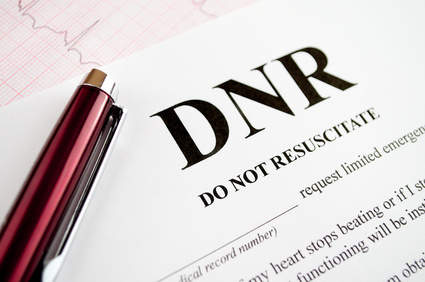End-of-Life Medical Treatment. More Documents for Preplanning, Part 2
- Details
- Published on Friday, 27 July 2012 13:45
In our last blog entitled, "End of Life Medical Treatment – Preplanning is Key! Part 1" we discussed Advance Directives, Living Wills, and Durable Power of Attorney for Health Care. In Part 2, we will discuss other end of life documents that you may want to consider having. We will start with what a "Do Not Resuscitate" form is, and how to make a decision on whether or not you want this form.
What is a Do Not Resuscitate form/order? A Do Not Resuscitate (DNR) Order is another type of advance directive. A DNR is a request not to have cardiopulmonary resuscitation (CPR) if your heart stops or if you stop breathing. For example, your loved one has stopped breathing and you call an ambulance. The ambulance attendants normally would do everything in their power to get them to start breathing again; however, if your loved one has signed a Do Not Resuscitate form, and you give a copy to them, they have no choice but to follow your loved one's wishes. Unless given other instructions, hospital staff will try to help any patient whose heart has stopped or who has stopped breathing. But, again, if you have a Do Not Resuscitate Form, they will follow the form. You can use an advance directive form or tell your doctor that you don't want to be resuscitated. Your doctor will put the DNR order in your medical chart. Doctors and hospitals in all states accept DNR orders.
A Do Not Resuscitate (DNR) Order is another type of advance directive. A DNR is a request not to have cardiopulmonary resuscitation (CPR) if your heart stops or if you stop breathing. For example, your loved one has stopped breathing and you call an ambulance. The ambulance attendants normally would do everything in their power to get them to start breathing again; however, if your loved one has signed a Do Not Resuscitate form, and you give a copy to them, they have no choice but to follow your loved one's wishes. Unless given other instructions, hospital staff will try to help any patient whose heart has stopped or who has stopped breathing. But, again, if you have a Do Not Resuscitate Form, they will follow the form. You can use an advance directive form or tell your doctor that you don't want to be resuscitated. Your doctor will put the DNR order in your medical chart. Doctors and hospitals in all states accept DNR orders.
Should I have an advance directive?
We discussed the definition of an Advance Directive in Part 1. But, how do you make the decision as to whether or not you want one? Keep in mind that by creating an advance directive, you are making preferences about medical care known before you're faced with a serious injury or illness. This will spare your loved ones the stress of making decisions about your care while you are sick. Any person 18 years of age or older can prepare an advance directive.
People who are seriously or terminally ill are more likely to have an advance directive. For example, someone who has terminal cancer might write that he/she does not want to be put on a respirator if she/he stops breathing. This action can reduce her/his suffering, increase their peace of mind and increase control over her/his death.
How to write an advance directive
There are several ways to write an advance directive.
- Use a form provided by your doctor.
- Write your wishes down by yourself.
- Call your health department or state department on aging to get a form.
- Call a lawyer.
- Use a computer software package for legal documents.
Advance directives do not have to be complicated legal documents. They can be short, simple statements about what you want done or not done if you can't speak for yourself. Remember, anything you write by yourself or with a computer software package should follow your state laws. You may also want to have what you have written reviewed by your doctor or a lawyer to make sure your directives are understood exactly as you intended. When you are satisfied with your directives, the orders should be notarized if possible, and copies should be given both to your family and doctor for their files.
We have covered several end of life pre-planning documents that can assist you in helping to make your family member comfortable with the knowledge that their end-of- life wishes will be fulfilled. Take comfort in the knowledge that if you have pre-planned and filled out these documents beforehand, you have done everything you can to ensure that their end-of- life is how they want it to be.
Which forms do you have? Which forms do you need to get?

